Nature Conservation 2022 — 25. 5. 2022 — On Nature in the Czech Republic — Print article in pdf
The Landscape of Cooperation – Forty Years of the Bílé Karpaty/White Carpathians Mts. Protected Land

What comes to mind when you hear the word the Bílé Karpaty/White Carpathians Mts.? A hundred years ago it was still the most remote corner of the Czech Republic, from which people were leaving for America to find a job. Today it is a popular destination for an increasing number of visitors of the entire country. Everyone will come up with something else – probably most often meadows full of orchids stretching to the horizon, but also (from west to east) wine cellars near the municipality of Petrov and the town of Strážnice, old service/sorb trees (Sorbus domestica), the Horňácko/Upper Moravian Slovakia region folk culture, the Moravian Kopanice region with the Goddesses of Žítková, the virgin forest below the top of Mt. Velká Javořina/Great Maple Forest, beech forests in the Vlára Pass, or the well-preserved landscape of Southern Moravian Wallachia around the municipality of Nedašov. The landscape and nature of the picturesque mountains on the Slovak border has really extremely many faces.
Already much has been written about natural beauty of the Czech Republic in this journal, therefore the author would rather like to complete the Bílé Karpaty/White Carpathian Mts. mosaic with shards about efforts of nature conservationists and particularly collaboration, as they would not be able to conserve local nature and the landscape on their own there. When the Bílé Karpaty/White Carpathians Protected Landscape Area (PLA) was festively declared in autumn 1980, it had had only one small-size protected area, the Mt. Velká Javořina/Great Maple Forest primary/virgin forest. Seven years later there were 49, most of them meadows and pastures! More details of this fantastic result can be found in Ochrana přírody/ Nature Conservation Journal, 72, 6, 2–5, 2017.
Landscape restoration and LIFE+
However, even the most remote areas had not escaped the devastating pressure of socialist agriculture. Therefore, in the 1990s the main challenge was landscape restoration. Hundreds of hectares of illegally ploughed meadows were ‘regrassed’, often with a regional herb seed mixture, whereas nearly three quarters of official arable land was converted to grassland for economic reasons and on the farmers’ own initiative. The long-term monitoring o permanent plots has demonstrated that the number of species (species richness) at sites restored in different ways gradually increases in the course of time.
Another significant success has been the extensive elimination of self-sowing encroaching woody plants. Due to the intensification of agriculture, meadows on steeper slopes were abandoned and became naturally seeded and encroached first with shrubs and later even trees. However, they have been still registered as a meadow, which makes a simple intervention administratively simple. Thanks to financ- es from the Ministry of the Environment of the Czech Republic as well as projects from the State Environmental Fund dozens of hectares have been restored. A rapid recovery of the species diversity has taken place at these sites, as they had not been exposed to the application of chemical fertilisers.
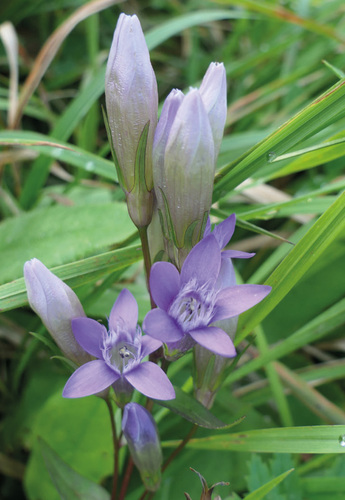
One of nine Carpathian gentians (Gentianella lutescens) that flowered in the Bílé Karpaty/White Carpathians Mts. in 2020. © Libor Ambrozek
After several years of silence caused by a lack of funds, a new chapter in the history of self-seeding woody plant elimination and eradication was written in 2011 with the Butterflies CZ-SK LIFE+ project (see issue no. 3/2015). And it has been written to this date for the benefit of the Bílé Karpaty/White Carpathians Mts. meadows and the plant and insects inhabiting them. The first successful project was followed up in 2017 by another, more broadly entitled From the Life of Insects, which besides meadow and pas- ture restoration also deals with interventions in woodlands. Both projects have brought tens of millions of CZK (EUR millions) from the European Union sources to the Bílé Karpaty/ White Carpathians Mts. and have, in addition to more active habitat management, supported the development of farmers’ involvement, communication, education and public awareness (CEPA), and last but not least also extensive monitoring of butterflies and other insect species.
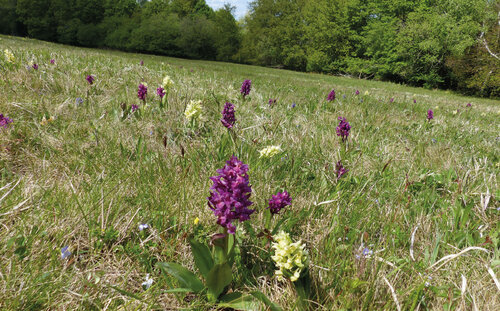
The colourful aspect of the Elder-flowered orchid (Dactylorhiza sambucina) is a decoration of species-rich orchid meadows (in central and northern parts of the mountain range). © Libor Ambrozek
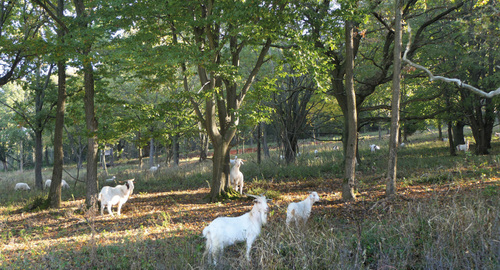
At Paličky near Javorník, 22 hectares of former pastures with solitary trees have been restored under both LIFE projects. © Libor Ambrozek
Under the first LIFE+, 110 hectares of invasive self-seeding woody plants were eliminated within the PLA, whereas the target of the second project is another 200 hectares. The sites are very diverse. In the Moravian Kopanice region, many local residents with land around their homesteads were involved. In the southern part even several-hectare large sites were restored (e.g. Paličky near Javorník, Roštovica near Tasov, slopes in the buffer zone of the Porážky National Nature Reserve), at which solitary trees have been preserved. Insect surveys at these sites have demonstrated a high species diversity including many rare species.
Species management
The management of rare wild plant and animal species, which the Bílé Karpaty/White Carpathians Mts. are very rich in, deserves a chapter of its own. The numbers of critically endangered species alone run into the dozens. Many of them are bound to meadows and pastures, but woodland species are neither forgotten. It is true that the area of permanent grasslands significantly narrows the space for ‘gardening’, but some sensitive species cannot do with special management and even then their future survival has not been guaranteed.
Gentians of the genus Gentianella are a textbook example. The Carpathian gentian (Gentianella lutescens) had once used to be a common species of pastures and grazed meadows in the entire Carpathians. However, under the influence of changes in farming methods and nitrogen deposition it rapidly disappeared in the second half of a decent fence around its main population at Porážky. In recent years, one of the two localities of the Lady’s-slipper (Cypripedium calceolus), the Čertoryje National Nature Reserve, has become the target of a nerdy who has gradually dug out all the flowering tufts. On the other hand, populations of the Late spider-orchid (Ophrys holoserica) are stable, and pyramidal orchid (Anacamptis pyramidalis) even appeared at formerly fertilised sites in 2020.
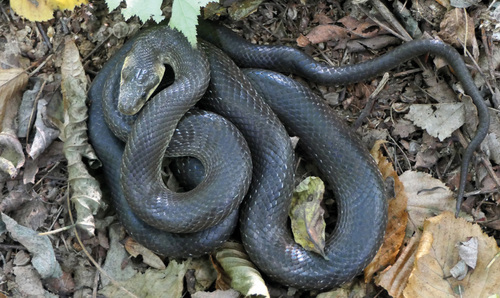
The Aesculapean snake (Zamenis longissimus), nicknamed ‘housekeeper snake’ in the Moravian Kopanice region. © Libor Ambrozek
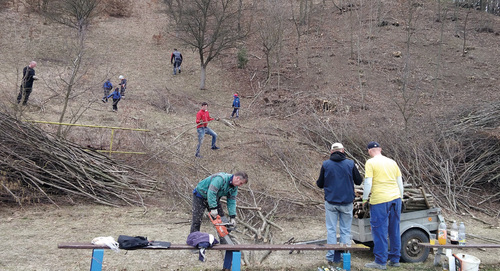
Removal of self-sowing encroached woody plants at Stráž near Bylnice, a significant entomological site. © Libor Ambrozek
If we leave out large carnivores, which have been surveyed in the Bílé Karpaty/White Carpathians Mts. for three years, the best known animals inhabiting the mountains are apparently the Aesculapean snake (Zamenis longissimus) and the Rosalia longicorn (Rosalia alpina). For our largest snake, known in the Moravian Kopanice area as ‘housekeeper snake’, a number of artificial hatcheries have been placed in Vlára Pass and at Žítková, where the snake is regularly monitored. Also the Rosalia longicorn, one of the most beautiful beetles in the Czech Republic, has its largest Czech population around the Vlára Pass. We have been trying to create a sufficient number of suitable habitats for the insect in collaboration with state forestry. Currently negotiations are taking place about more sensitive management in well-preserved beech forests adjacent to the old-growth forests of two Nature Reserves, Okrouhlá and Sidonie. In surveys, a number of other beetle species not occurring elsewhere in the Czech Republic were also found there.
Besides the meadows in the southern part, also the surrounding of Brumov-Bylnice takes in an exceptional position among entomological localities. Thanks to the proximity of the Váh River, rare thermophilic beetle species and other insects arrive there. Some of them, long regarded as extinct from the Czech Republic, have newly been discovered there (e.g. the Critically Endangered leaf beetle Cassida atrata). Recently, slopes of the most valuable site of Stráž near Bylnice have gradually been cleaned of shrubs. As part of the LIFE+ project the PLA Administration collaborates the 20th century. Now we can count the sites and in dry years even flowering individuals on our fingers. In 2020 it flowered at only two of the monitored six sites, representing a total of 13 plants only. Although the sites of its occurrence are regularly cleaned by raking in spring and mowing takes place in late autumn, the populations are very poor. At least the resumption of mowing at a site near Nedašov has been successful. There, its original farmer stopped maintaining the meadow several years ago after disputes with nature conservationists. Two years after mowing was resumed, 9 gentians germinated from the seedbank were found flowering.
The Autumn dwarf gentian (Gentianella am- arelle) is in a much better situation. The species has recently been found at three sites. At two of them, old sunken pathways, even several hundred specimens flower in good years (more than 600 near Javorník and 300 near Nová Lhota in 2020). Another species honoured with a recovery programme or at least an action plan and doing well is the endemic fleawort Tephroseris longifolia moravica (several hundred flowering plants at the two largest sites in 2020). Also the only population of the Spiked star-of-Bethlehem (Ornithogalum pyrenaicum sphaerocarpum) grows slightly. The lousewort Pedicularis exaltata, one the PLA’s iconic species, received there with landowners and local associations, for example footballers who play on the pitch directly below the slope.
Amphibian populations benefit from new pools which are restored by e.g. hunting associations and local chapters of the Czech Union for Nature Conservation. Thanks to more thorough monitoring (particularly caused by the boom in camera traps) but also because of changes in woodlands, more and more new species are being observed. Examples are the Eurasian three-toed woodpecker (Picoides tridactylus), Ural owl (Strix uralensis) and the European wild- cat (Felix silvestris).
Cooperation with farmers
There are many ways of cooperation with lo- cal residents and farmers. The remoteness of the Bílé Karpaty/White Carpathians Mts. is fully manifested there not only in the exceptionally preserved folk culture but also in the relation to the land and landscape around. Next to larger farmers, traditional farmers can still be encountered there, and now and then we find more species on their land than in nature reserves. It looks like plants and animals are sometimes able to appreciate the management that given to them. This is because we do by far not know everything about them. It is therefore appropriate to perceive all farming methods.
The extent of collaboration is reflected by the fact that 18 thousand hectares of perma- nent meadow/grassland are included in the Agri-environment-climate measures (AECM) subsidy schemes, which is more than a quar- ter of the PLA’s size! The proportion of land farmed organically is even slightly larger: 70% of farmland as registered in the Land Parcel Identification System. Moreover, six thousand hectares of meadows and pastures are located in Zones I and II. Thanks to the activities under and finances from the LIFE+ ‘butterfly’ project the PLA Administration has started to meet with farmers on a regular basis. The debate is not only about farming subsidies, the weather or requirements of the PLA Administration, but we have also tried to explain the motives and intentions for the way we act. This has shown to be extremely successful. Even hardened landowners became impressed by a colourful description of the life cycle of blue butterflies and then reconciled with mosaic mowing much easier.
Besides mowing and grazing subsidies the PLA Administration also supports other farming activities. More and more arable land is regrassed with regional seed mixtures, and some stakeholders plant solitary trees in meadows. Javorník CZ Farm Company has even implemented two large landscape structure restoration projects under the Operational Programme Environment (OPE), i.e EU funds. Resources of the Landscape Management Programme for the planting of fruit tree landraces have gained great popularity, being used by dozens of small applicants. A similarly successful subsidy pro- gramme of the Ministry of Industry and Trade of the Czech Republic for the building of new fruit distilleries would be useful now.
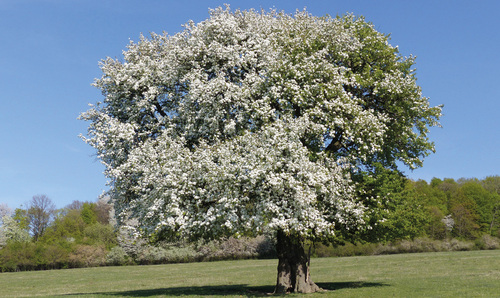
Wild pear tree in the proximity of the Drahy Nature Reserve, one of the oldest in the Bílé Karpaty/White Carpathians Mts. © Libor Ambrozek
Municipalities and non-profit organisations
For more than 20 years the PLA Administration has regularly been meeting with the mayors. Due to their activity, the Administration has one of the highest number of OPE projects to assess within the Nature Conservation Agency of the Czech Republic as a whole. We support the planting of lines of trees and treatment of old trees. Some municipalities maintain valuable sites on their territory themselves. These are mostly former municipal pastures which are now refuges for many rare species.
A separate chapter is formed by PLA Administration’s cooperation with natural allies, non-profit organisations in nature conservation. Some of them have gained reputation outside the region. Kosenka, a Local Chapter (LC) of the Czech Union for Nature Conservation (CUNC), has purchased 30 hectares of an old fir forest named Ščúrnica and two meadow reserves. Their traditional mowing event was held for the 40th time in 2020! Kosenka members also stood at the birth of one of the largest events in the region, the Wallachian St. Nicolas Fair in the town of Valašské Klobouky.
LC CUNC Bílé Karpaty operates in the south, where it manages more than 200 hectares of valuable orchid meadows. It participates in both LIFE+ projects and its role as a regional grass mixture producer is irreplaceable. In 1997 it established, together with the PLA Administration and the Municipality of Veselí nad Moravou, the Bílé Karpaty/White Carpathians Mts. Education and Information Centre, today the main CEPA centre in the region. Their lesson package named The Meadow Secret enjoys great popularity with schools of all levels, and also field excursions and tourist guide trainings are in demand.
At the end of our probe into the world of the Bílé Karpaty/White Carpathians Mts., the international aspects of our mountain range must be mentioned. On the other side of the ridge, our Slovak colleagues from the Biele Karpaty/ White Carpathians Mts. PLA operate, even one year longer than we have done. Their work is not easy because Slovak state nature conservation has very limited possibilities compared to those in the Czech Republic, but they have done a huge piece of work thanks to their enthusiasm. We met each other in the first LIFE+ project, under which they bought their own equipment, now used to manage several dozen hectares of the most valuable protected areas. Nongovernmental organisation BROZ, which also participates in the other LIFE+ project, is just as active: it manages a range of sites, i.a. a large orchard, and cooperates closely with local farmers.
A charming beauty of the Bílé Karpaty/White Carpathians Mts. landscape and its natural treasure jointly formed by humans have been able to win recognition also abroad. In 1996, the Bílé Karpaty/White Carpathians Mts. were declared UNESCO Biosphere Reserve and since 2000, they have been a holding area of the European Diploma for Protected Areas awarded by the Council of Europe which was prolonged for the second time in autumn 2020. These awards are an appreciation of all the local and non-local people who live and farm in the region and have left a piece of their heart there. You will leave it there too when you walk through the meadows and forests and sing a song with the locals over a glass in the evening. ■
- - -
Intro photo: The South Wallachian landscape near the municipality of Nedašov. © Libor Ambrozek

